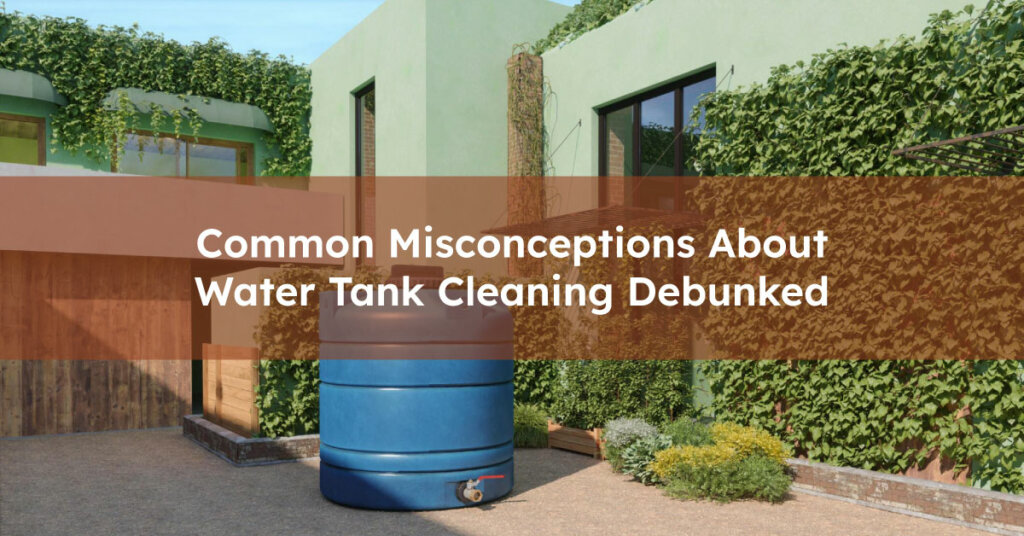Did you know that there are several misconceptions surrounding water tank cleaning? These misconceptions often lead to neglect of this essential maintenance task, putting the safety and purity of your water supply at risk. In this article, we will debunk frequently believed water tank cleaning misconceptions and provide you with the facts you need to know.

Water tank cleaning is crucial for maintaining a safe and reliable water supply, regardless of the type of water source or the presence of chemical disinfection. By gaining a better understanding of the importance of regular water tank cleaning, you can ensure the cleanliness and safety of your water supply for you and your family.
Table of Contents
Key Takeaways
- Water tank cleaning is necessary for all types of water sources, including treated water.
- Chemical disinfection alone is not enough to ensure clean water.
- Professional expertise is crucial for effective water tank cleaning.
- Proper cleaning techniques can prevent tank damage during water tank cleaning.
- Regular water tank cleaning is important regardless of visible dirt.
If you’re looking for a reliable water tank cleaning company in Dubai contact us on WhatsApp today.
1: Water Tank Cleaning Is Not Necessary for Treated Water
Water tank cleaning is important for all types of water sources, including treated water. Contrary to popular belief, treating the water with chemicals alone is not enough to ensure its cleanliness and safety.
Water Tank Cleaning Is Important for All Types of Water Sources
Even if your water supply undergoes chemical disinfection, regular cleaning of the water tank is essential. The process of treating water involves using chemicals to kill or deactivate harmful microorganisms. However, this does not address other potential issues that can arise in the water tank itself.
Over time, sediments, debris, and biofilm can accumulate in the water tank, compromising the overall quality of the water. These impurities can introduce harmful bacteria, viruses, and parasites, putting your health at risk.
By regularly cleaning the water tank, you can remove these contaminants and maintain a clean and safe water supply for your household. Consistent water tank cleaning is particularly crucial in regions where water scarcity is a concern, as it allows you to make the most of your available water resources.
It is also worth noting that untreated water sources, such as groundwater or rainwater harvesting systems, require even more stringent cleaning measures, given the absence of chemical disinfection. These sources are more susceptible to contamination, making regular water tank cleaning an absolute necessity.
Importance of Water Tank Cleaning for all Water Sources:
Whether your water is treated or untreated, regular water tank cleaning is essential for maintaining the quality and safety of your water supply. By adhering to a routine cleaning schedule, you can eliminate hidden contaminants, prevent the buildup of sediments and biofilm, and ensure that your water remains pure and suitable for consumption.
2: Chemical Disinfectants Alone Ensure Water Safety
While chemical disinfectants play a crucial role in eliminating harmful microorganisms, it is important to understand their limitations. The effectiveness of chemical disinfection in ensuring clean water is limited to the eradication of microorganisms. However, chemical disinfection alone cannot address physical impurities such as sediment or dirt that may accumulate in the water tank.
To ensure optimal water safety, it is essential to complement chemical disinfection with regular water tank cleaning. By incorporating a comprehensive cleaning regimen alongside chemical disinfection, you can address both microbial and physical contaminants that may compromise the purity and safety of your water supply.
The Limitations of Chemical Disinfection in Ensuring Clean Water
Chemical disinfection, typically achieved through the use of chlorine or other sanitizers, is effective in killing or inhibiting the growth of bacteria, viruses, and other microorganisms in the water tank. This process is instrumental in preventing waterborne diseases and ensuring water safety. However, chemical disinfectants have their limitations:
- Limited impact on physical impurities: Chemical disinfection does not remove sediment, dirt, rust, or other physical contaminants that may accumulate in the water tank over time. These impurities can adversely affect water quality and pose risks to human health if left unaddressed.
- Inefficacy against biofilm: Biofilm refers to the slimy layer that can develop on the surfaces of the water tank. Chemical disinfection alone may not effectively remove or prevent the formation of biofilm. Biofilm can harbor bacteria, algae, and other microorganisms, compromising water quality.
- Kinetic limitations: The effectiveness of chemical disinfection is influenced by factors such as contact time, concentration, and temperature. Variations in these factors can impact the efficacy of disinfection, allowing some microorganisms to survive and potentially pose health risks.
To address these limitations and ensure the highest standards of water safety, it is essential to combine chemical disinfection with regular water tank cleaning.
| Chemical Disinfection | Water Tank Cleaning |
|---|---|
| Eliminates microbial contaminants | Removes physical impurities |
| Does not address sediment or dirt | Prevents biofilm formation |
| Has kinetic limitations | Maintains water quality |
By combining these two essential practices, you can ensure that your water supply remains safe, pure, and free from both microbial and physical contaminants.
3: Water Tank Cleaning Is a DIY Job
The Professional Expertise Required for Effective Water Tank Cleaning
While it may be tempting to take on the task of cleaning your water tank yourself, it is important to understand the expertise and skills required for thorough and effective cleaning. Hiring a professional water tank cleaning company offers several benefits that ensure the cleanliness and safety of your water supply.
Here are some of the key reasons why professional water tank cleaning is important:
- Specialized Equipment: Professional cleaning companies have access to advanced equipment and tools specifically designed for water tank cleaning. This enables them to effectively remove contaminants and thoroughly clean every corner of the tank.
- Knowledge and Experience: Professionals have in-depth knowledge of the best practices and techniques required for water tank cleaning. They understand the complexities involved in ensuring a sanitized tank and can address any potential issues that may arise during the process.
- Compliance with Regulations: Water tank cleaning must meet specific health and safety regulations. Professional companies are well-versed in these regulations and can ensure that your tank cleaning is conducted in accordance with the required standards.
- Time and Convenience: Cleaning a water tank is a time-consuming task that requires careful planning and execution. By hiring professionals, you can save valuable time and focus on other important aspects of your life or business.
- Peace of Mind: Knowing that your water tank is being cleaned by professionals provides peace of mind, as they are trained to identify and address potential issues that can impact the quality of your water supply.
By hiring a professional water tank cleaning company, you can ensure that your water tank is thoroughly and effectively cleaned, maintaining the purity and safety of your water supply.
4: Frequent Water Tank Cleaning Can Damage the Tank
Contrary to popular belief, frequent water tank cleaning does not damage the tank when proper cleaning techniques are employed. By following safe water tank cleaning practices, you can maintain the integrity of the tank while ensuring a clean and healthy water supply.
When cleaning your water tank, it is important to avoid using harsh abrasives or high-pressure washing, as these can cause damage to the tank’s surface. Instead, opt for gentle cleaning methods that effectively remove impurities without compromising the tank’s structure.
Here are some safe water tank cleaning practices to prevent tank damage:
- Use non-abrasive cleaning agents: Opt for mild detergents or disinfectants specifically formulated for water tank cleaning. These products are designed to effectively remove contaminants without corroding or damaging the tank.
- Scrub gently: When cleaning the tank, use soft brushes or sponges to scrub away dirt and debris. Avoid using rough materials that can scratch or scrape the tank’s surface.
- Rinse thoroughly: After cleaning, ensure that you thoroughly rinse the tank to remove any residue from cleaning agents. Residual chemicals can affect the water quality and potentially cause harm.
- Inspect for cracks or leaks: While cleaning the tank, take the opportunity to inspect for any signs of damage, such as cracks or leaks. If any issues are detected, it is important to address them promptly to prevent further damage.
By following these proper cleaning techniques, you can maintain the structural integrity of your water tank while ensuring that it remains clean and free from contaminants. Regular maintenance and cleaning not only prevent damage but also extend the lifespan of the tank, saving you from costly repairs or replacements.
5: Only Visible Dirt Indicates the Need for Cleaning
The Importance of Regular Water Tank Cleaning Regardless of Visible Dirt.
Relying solely on visible dirt to determine the need for cleaning is a misconception. Water tanks can harbor hidden contaminants, such as bacteria or biofilm, that may not be visible to the naked eye. Regular water tank cleaning is essential for preventing the buildup of these contaminants and ensuring the safety of your water supply.
| Hidden Contaminants | Health Risks |
|---|---|
| Bacteria | Potential for waterborne illnesses |
| Biofilm | Reduced water quality and taste |
| Algae | Possibility of foul odor and taste |
| Sediments | Potential blockage of pipes and plumbing issues |
Even if your water tank appears visually clean, these hidden contaminants can still be present, affecting the quality of the water you consume. Through regular preventive cleaning, you can remove these hidden contaminants and maintain a clean and safe water supply for your household.
Don’t wait for visible dirt or unpleasant odors to arise before taking action. Schedule regular water tank cleaning to ensure that your water remains pure and free from harmful contaminants.
6: Water Tank Cleaning Is Expensive and Not Cost-Effective
The Cost-Effectiveness of Regular Water Tank Cleaning
While some may view water tank cleaning as an expensive endeavor, it is actually a cost-effective investment. Regular cleaning can prevent costly repairs or replacements that may be necessary due to neglected maintenance. Additionally, ensuring a clean water supply can minimize the risk of waterborne illnesses, reducing healthcare costs in the long run.
By regularly cleaning your water tank, you can enjoy the following benefits:
- Prevent costly repairs or replacements: Regular maintenance and cleaning can help identify and address any potential issues early on, avoiding the need for expensive repairs or replacements in the future.
- Ensure waterborne illness prevention: A clean water supply free from contaminants reduces the risk of waterborne illnesses, reducing the need for medical treatments and associated costs.
- Improve water efficiency: Clean tanks allow for efficient water flow, reducing water wastage and saving on water bills.
- Prolong tank lifespan: Regular cleaning prevents the accumulation of sediment, rust, and other materials that can degrade the tank, extending its lifespan and avoiding the need for premature replacement.
Investing in regular water tank cleaning not only safeguards the health and well-being of your household but also leads to long-term savings. By prioritizing the cleanliness of your water supply, you can avoid costly repairs, minimize healthcare expenses, and promote water efficiency for a more sustainable future.
7: All Water Tank Cleaning Services Are the Same
When it comes to water tank cleaning, not all services are created equal. To ensure the task is carried out effectively and in adherence to industry standards, it is crucial to choose a reliable and professional water tank cleaning company. Consider the following factors when making your selection:
Experience
Look for a company with extensive experience in water tank cleaning. A long-standing presence in the industry indicates expertise and a proven track record of delivering quality service.
Certifications
Check if the company holds any relevant certifications. These certifications demonstrate that the company adheres to strict standards and follows best practices in water tank cleaning.
Equipment
Ensure that the company has the necessary equipment to perform thorough and efficient water tank cleaning. The use of modern and specialized equipment is essential for effective removal of contaminants.
Customer Reviews
Read customer reviews and testimonials to gauge the satisfaction level of past clients. Positive reviews are an indication of reliable service and customer satisfaction.
Comprehensive Guide to Water Tank Cleaning
For a more comprehensive understanding of water tank cleaning in Dubai, be sure to check out our article the comprehensive guide to water tank cleaning in Dubai. This guide provides in-depth information on the importance of water tank cleaning and offers valuable insights for maintaining a safe and pure water supply.
Conclusion
Now that we have debunked common misconceptions about water tank cleaning, it is clear that this maintenance task is essential for ensuring a safe and pure water supply. Regularly cleaning your water tank can help prevent the buildup of contaminants, such as bacteria or biofilm, that may affect the quality of your water. By seeking professional assistance and following proper cleaning techniques, you can maintain optimal water quality and safeguard the health of your family.
FAQ
Do chemical disinfectants replace the need for physical cleaning of water tanks?
While chemical disinfectants play a crucial role in killing bacteria and viruses, they cannot remove physical contaminants such as sediment, rust, and algae. Physical cleaning is essential to eliminate these substances before disinfection for effective water tank maintenance.
Can small water tanks be cleaned less frequently than large ones?
The size of the tank does not necessarily dictate cleaning frequency. Small tanks can still accumulate contaminants quickly, especially if the water source is of lower quality or if the tank is exposed to environmental pollutants. Regular cleaning is essential for all tank sizes to ensure water quality.
Does boiling water eliminate the need for water tank cleaning?
Boiling water can kill bacteria and viruses, but it does not remove chemical contaminants, heavy metals, or sediments present in the water. Thus, boiling water is not a substitute for regular water tank cleaning and maintenance.
If my water tank is made of stainless steel, does it still need to be cleaned?
Yes, even stainless steel water tanks need regular cleaning. While stainless steel is resistant to corrosion, it does not prevent the buildup of sediments, biofilm, or microbial growth inside the tank. Regular cleaning is necessary to maintain water purity and safety.




